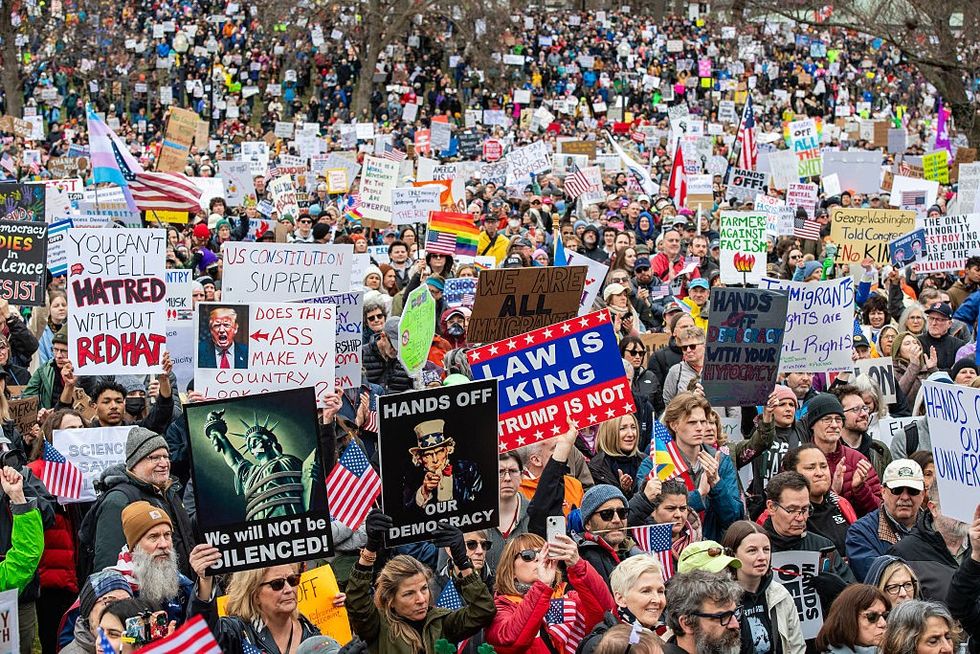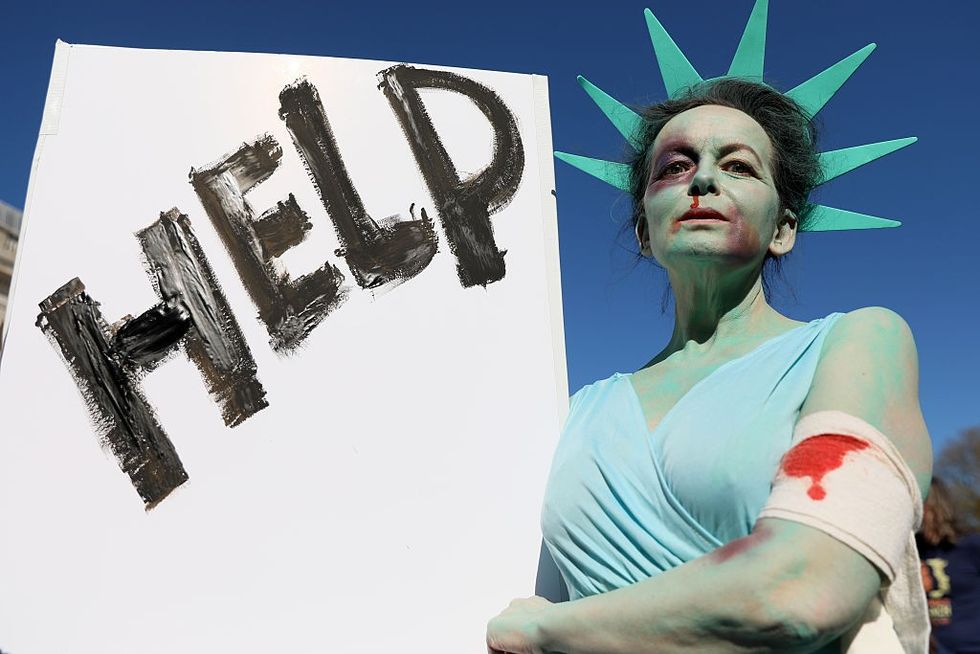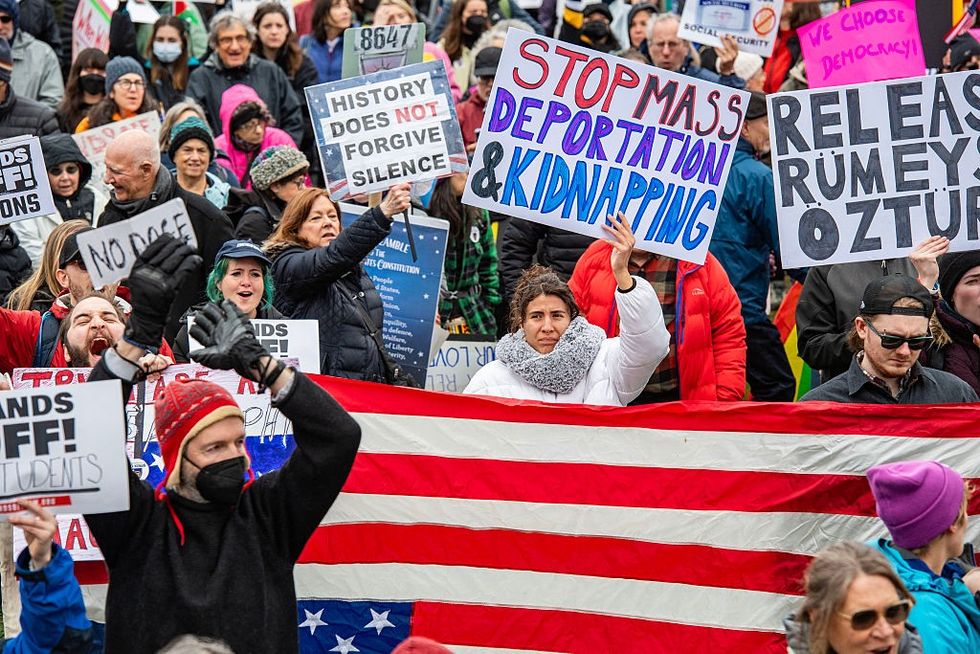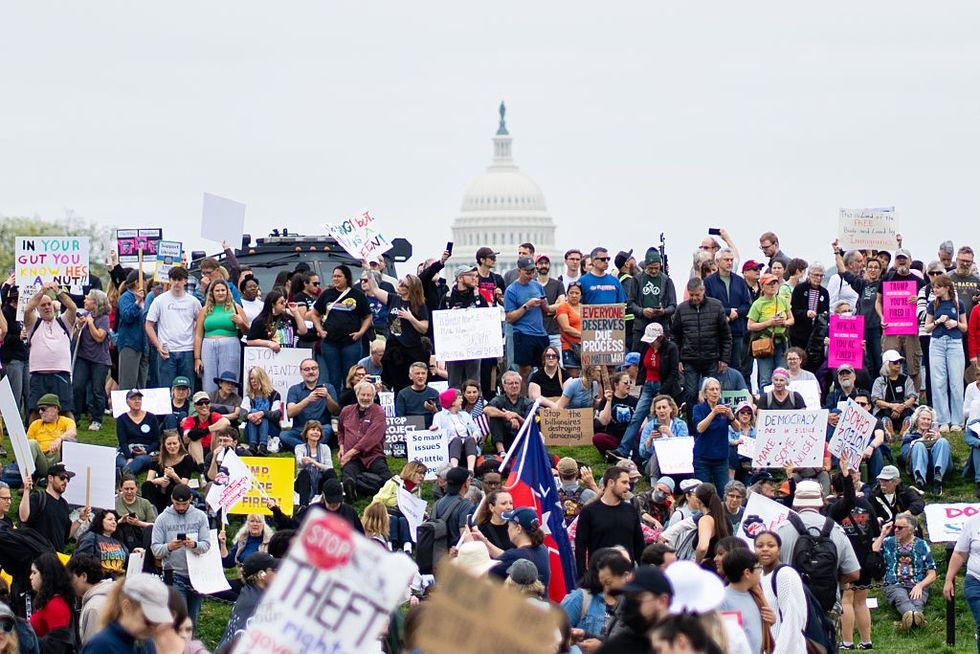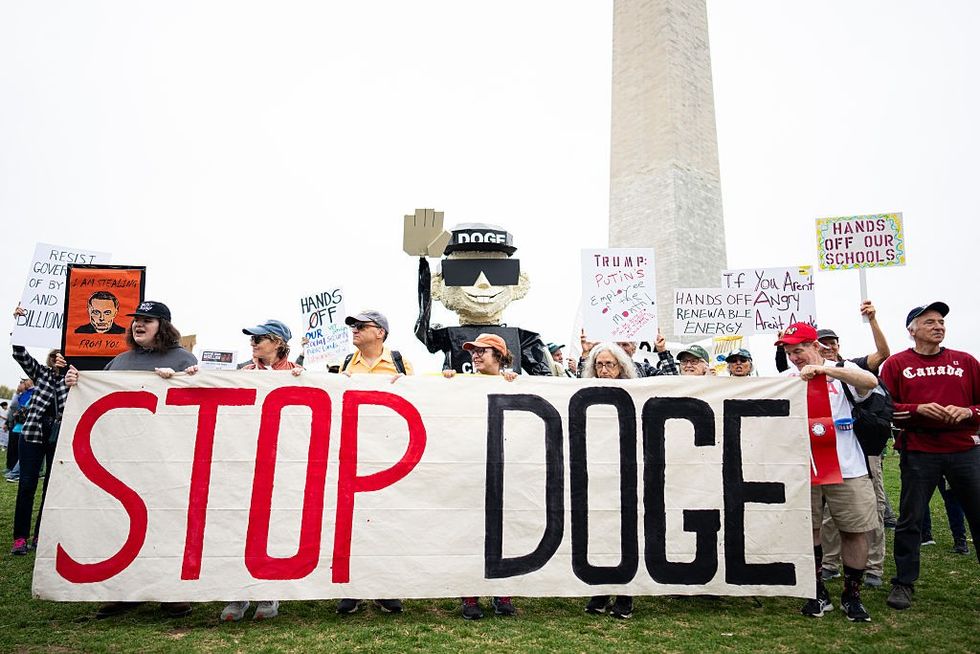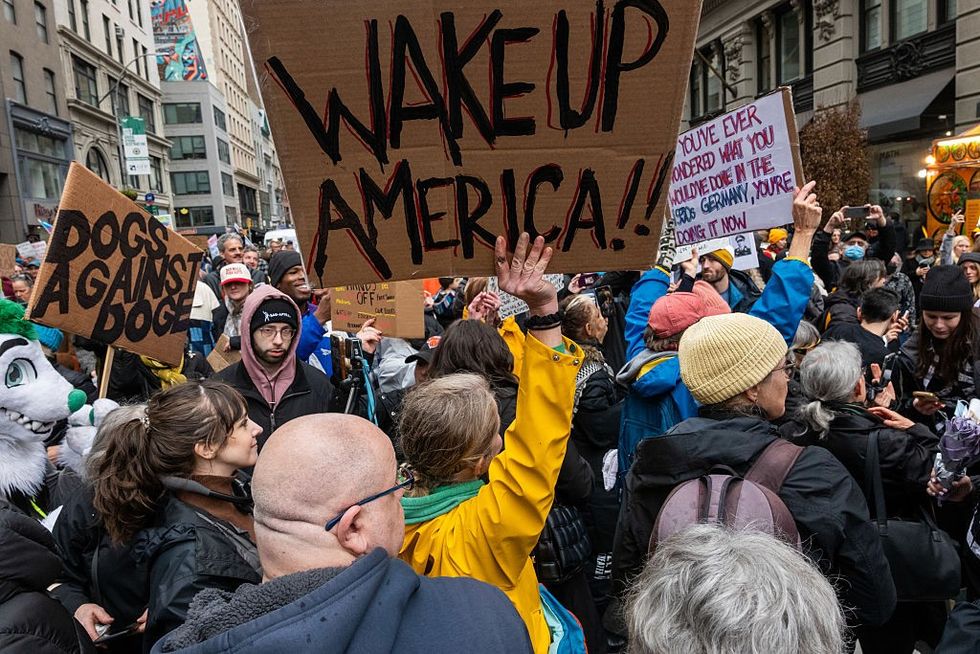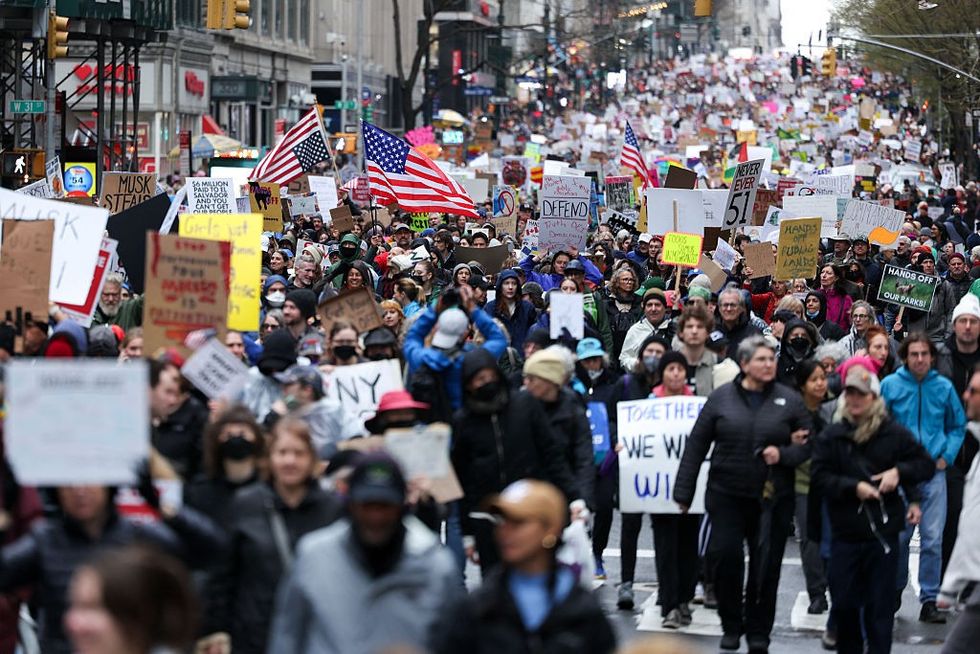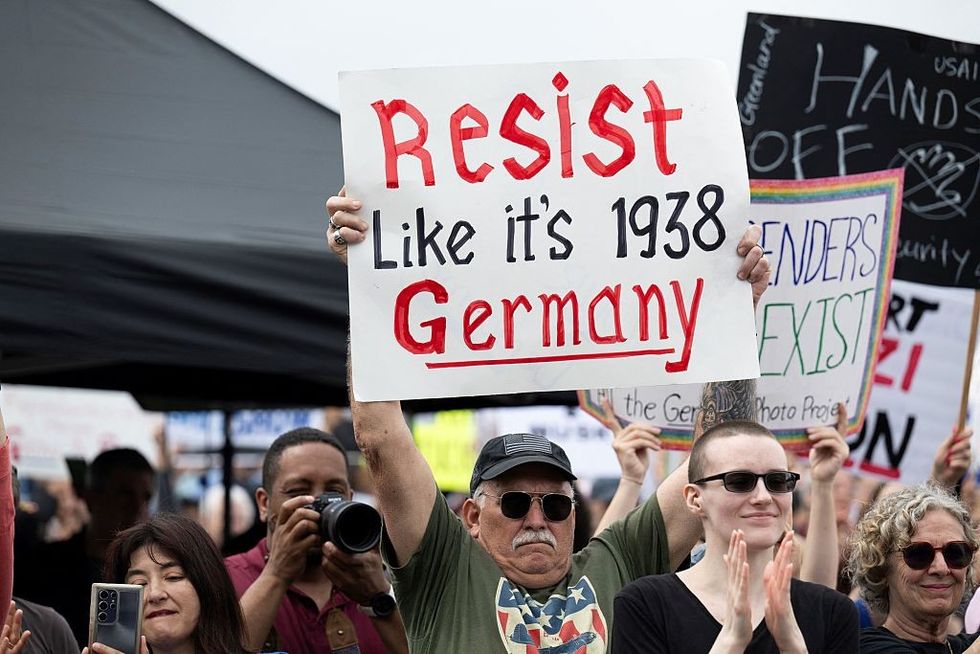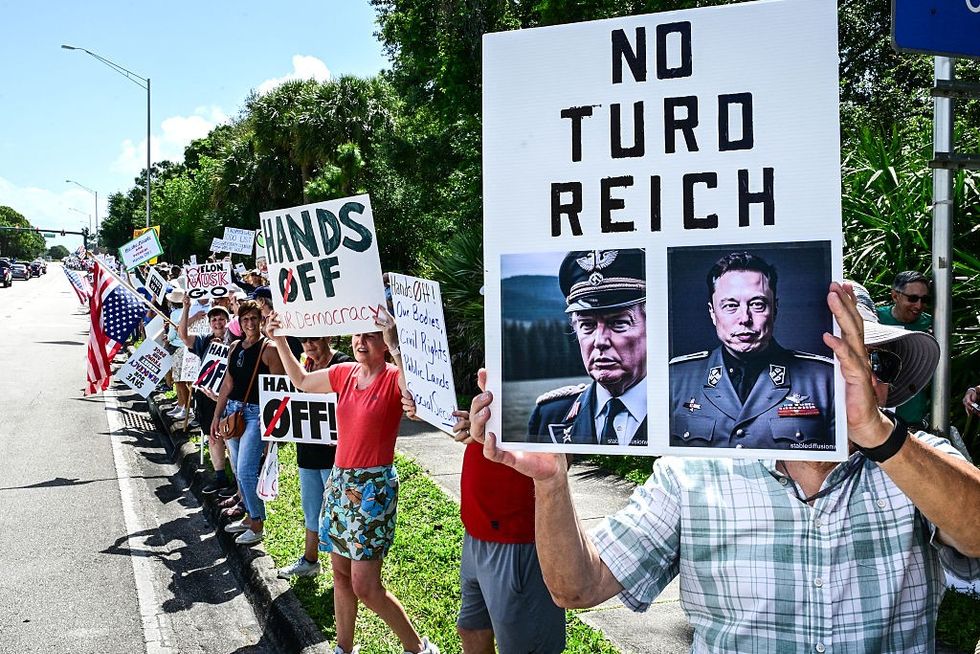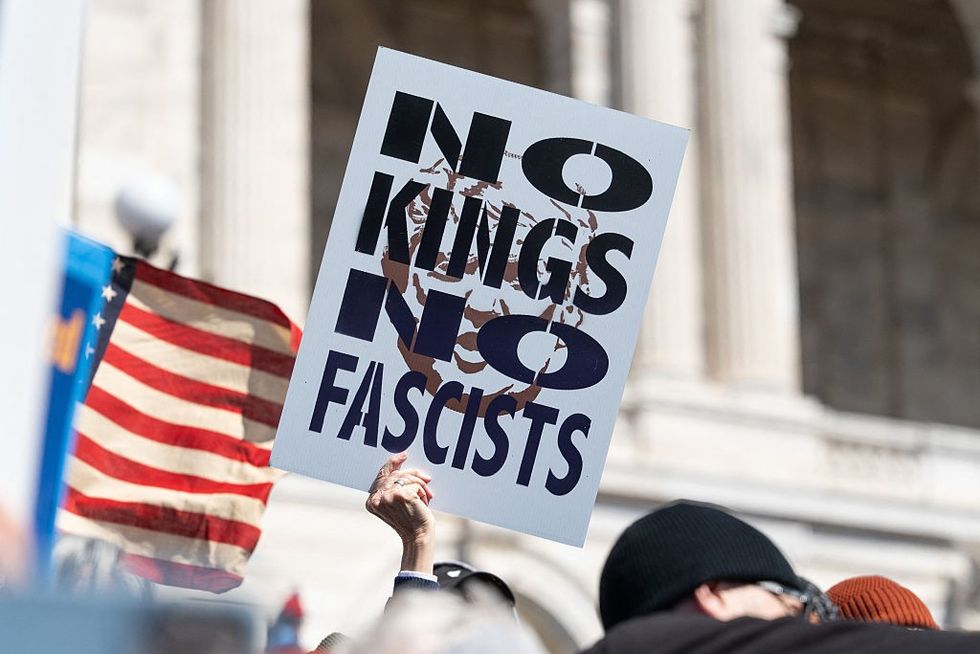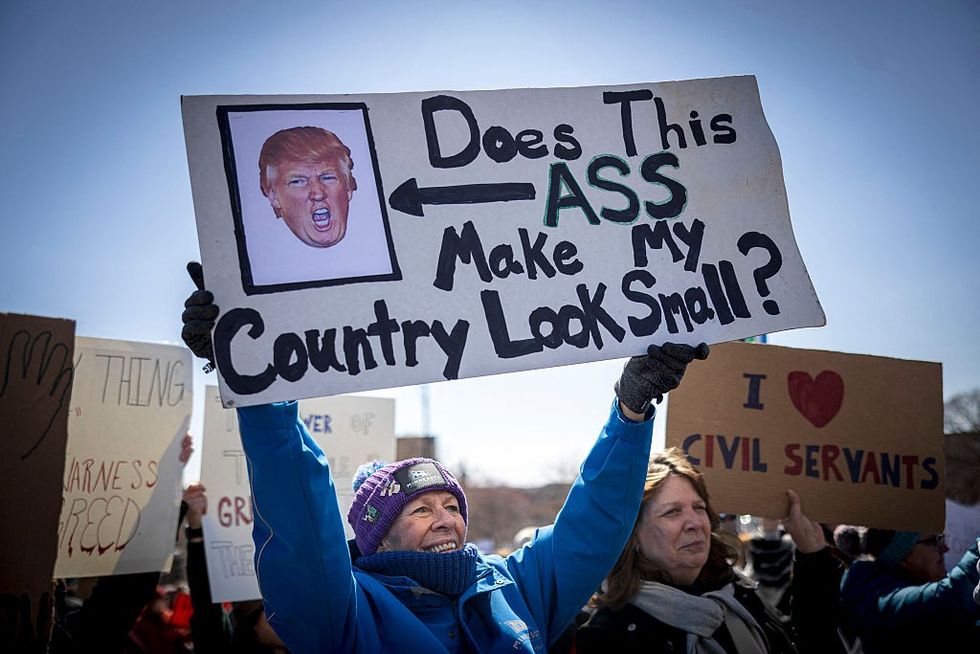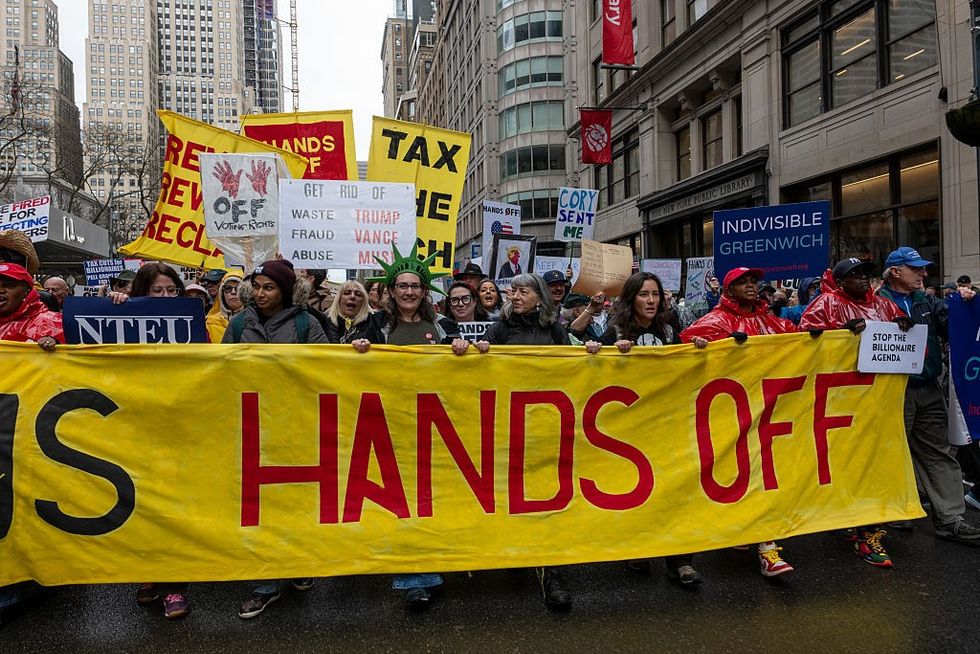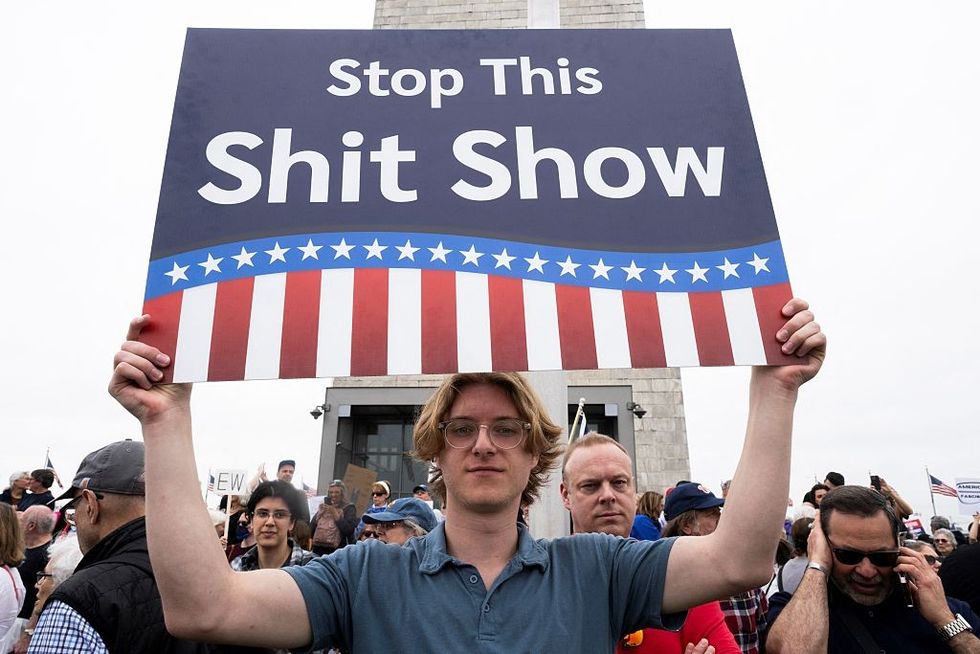

SUBSCRIBE TO OUR FREE NEWSLETTER
Daily news & progressive opinion—funded by the people, not the corporations—delivered straight to your inbox.
5
#000000
#FFFFFF
To donate by check, phone, or other method, see our More Ways to Give page.


Daily news & progressive opinion—funded by the people, not the corporations—delivered straight to your inbox.
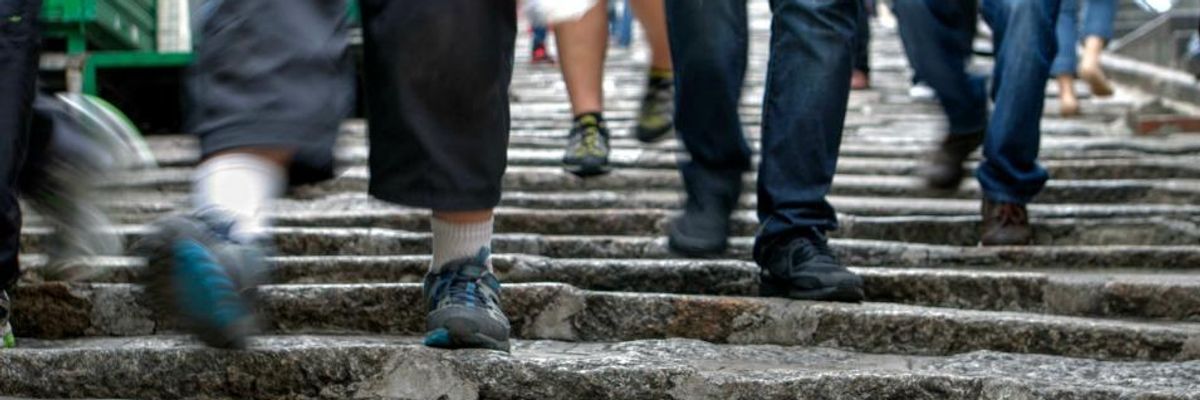
Evidence that millions of Americans' are now rediscovering walking for transportation, fitness and fun is as solid as the sidewalk beneath our feet. (Photo: Peter Thoeny/flickr/cc)
Walking is going places.
Humans' most common pastime--forsaken for decades as too slow and too much effort-- is now recognized as a health breakthrough, an economic catalyst and a route to happiness.
Real Simple magazine (circulation: 2 million) declared "walking America's untrendiest trend" in its February 2014 cover story. A month later Builder magazine (a construction trade journal) announced on its cover, "Walkability. Why we care...and why you should too." The reason? Simple: "Increasingly, the market is demanding places where homeowners can hoof it."
The New Yorker weighed in last September quoting the new book A Philosophy of Walking, which asserts that walking "makes it possible to recover the pure sensation of being, to rediscover the simple joy of existing."
This sheer pleasure of walking is highlighted in one of the year's top music videos, "Happy" by soul singer Pharrell Williams. It's an exuberant celebration of life on foot showing all kinds of people (including Magic Johnson, Steve Carrell and Jimmy Kimmel) strutting, stepping, striding and sashaying down city streets. It's been viewed 465 million times on You Tube.
There is sure to be continuing coverage of foot power next year when the Surgeon General's office releases a Call to Action on the health and social benefits of walking and walkable communities--a step some are comparing to the 1964 Surgeon General's Report on the dangers of smoking.
Already the Centers for Disease Control and Prevention (CDC) recommends all adults engage in 30 minutes of physical activity such as walking five days a week based on the proven connection between moderate physical activity and lower incidences of major medical problems--not just heart disease, diabetes and obesity, as you'd expect, but also depression, dementia, anxiety, colon cancer, osteoporosis and other serious conditions.
This flurry of attention about walking is more than a flash-in-the-pan. Evidence that millions of Americans' are now rediscovering walking for transportation, fitness and fun is as solid as the sidewalk beneath our feet.
Americans Are Getting Back on their Feet
"Walking is the most common form of physical activity across incomes and ages and education levels," explained Thomas Schmid of the federal Centers for Disease Control and Prevention (CDC) at the Pro-Walk, Pro-Bike Pro-Place conference in Pittsburgh this fall. The CDC's most recent research shows the number of Americans who take a walk at least once a week rose from 56 percent in 2005 to 62 percent in 2010-- which represents almost 20 million more people on their feet.
Speaking on the same panel, Paul Herberling of the US Department of Transportation noted that 10.4 percent of all trips Americans make are on foot--and 28 percent of trips under a mile. For young people, it's 17 percent of percent of all trips. Americans walk most frequently for exercise, errands and recreation, according to the National Highway Traffic Safety Administration.
Last year the first-ever Walking Summit was held in Washington DC, drawing more than 400 people from 41 states and Canada representing 235 organizations ranging from the PGA Tour to the Sioux Falls (South Dakota) Department of Health. A second summit is scheduled for October 28-30, 2015 in Washington, DC.
The 2013 summit, which sold out weeks in an advance, marked the birth of a new walking movement committed to: 1) encouraging everyone to walk more; and 2) boosting policies, practices and investments that make communities everywhere more walkable. It was convened by the Every Body Walk! Collaborative, a joint effort of more than 100 influential organizations across many fields to promote walking as part of the solution to problems ranging from chronic disease and health care costs to climate change and the decline of community.
The Every Body Walk! Collaborative (EBWC), which was catalyzed by Kaiser Permanente--a non-profit health care system serving 9.5 million people--includes major institutions like AARP, NAACP, the PTA and the American College of Sports Medicine as well as grassroots organizations . America Walks, a coalition of pedestrian advocacy groups, helps lead EBWC.
"In addition to the health benefits of getting regular physical activity, people's health can be correlated to having strong relationships, and living in connected communities with high levels of social cohesion," said Kaiser Permanente Vice-President Tyler Norris at the Pro-Walk Pro-Bike Pro-Place conference. "Among the important determinants of this sense of belonging is 'Do I know my neighbors?' A walkable community fosters these connections every day by helping us meet people we otherwise wouldn't."
Americans overwhelmingly view walking as a good thing, according to a national survey from GfK Research sponsored by Kaiser Permanente. Here are some of benefits of walking shown in the survey:
Even the American dream is being remodeled to meet the public's growing enthusiasm for walking. Sixty percent of Americans would prefer to live in a neighborhood with stores and services within easy walking distance, according to a recent survey from the National Association of Realtors, nearly twice as many who want to live where stores can be reached only by car.
This is especially true for the millennial generation, who are now entering the workforce and housing market in large numbers. "With drastically different views of transportation from those of generations that came before them, millennials are transforming communities," notes another report from the National Association of Realtors...." Millennials own fewer cars and drive less than their predecessors. They'd rather walk, bike, car-share and use public transportation--and want to live where that's all easy."
Why Walking? Why Now?
What's driving the growing passion for walking? "It's a convergence of factors", says Christopher Leinberger, a real estate developer, George Washington University business professor and a leading advocate that walkable communities are crucial to our future prosperity:
Walking Means Business
Firms in the booming tech, information and creative industries are at the forefront of the trend toward walkable communities because the coveted young talent they need to stay competitive in fast-changing fields want to work in places a short stroll from cafes and cultural attractions.
The first thing Google did after buying the electronics firm Motorola Mobility was to move its headquarters away from the freeways and strip malls of Libertyville, Illinois to the walkable environs of downtown Chicago. "They felt like they couldn't attract the young software engineers they needed" to an isolated 84-acre complex, says Leinberger. Other companies that recently moved from suburban Chicago to the city include Medline, Walgreen's, Gogo, GE Transportation, Hillshire Brands and Motorola Solutions.
"Two things seem to resonating for businesses about the importance of walkability--how to attract the best workforce and wanting to locate in communities where health costs are lower," says Mark Fenton, a former US National Team race walker who now consults on public health planning and transportation. Employees with more opportunities to walk at work and at home are healthier, meaning lower insurance rates for their firms.
From his vantage point at the CDC, Thomas Schmid observes, "If a business is located in a community that is not healthy, they're paying more to be there. Think of it as a tax or cost of doing business because of health care costs." One company relocating to Chattanooga, he said, would do so only if a walking and bike trail was extended to their facility.
The Challenges to a More Walkable America
The walking movement has picked up a lot of momentum in a very short time. "The wind is behind our sails," says Kate Kraft, a public health expert working with EBWC and America Walks. But she goes on to note that "it took 80 years to make America unwalkable, and it will take a lot of work to make it walkable again".
Last year's national survey on Americans' attitudes to walking accentuates these challenges. By a huge majority, people say that walking is good for them but also admit that they should walk more (79 percent) and that their children should walk more (73 percent). Only 11 percent say they meet the CDC's recommended daily minimum for walking--half an hour a day five days a week.
Common reasons cited for not walking are:
Solutions for a More Walkable America
Here are some of the promising developments, strategies, messages and tools that are now emerging to promote walking:
Vision Zero for Safe Streets: 4500 Americans are killed crossing the street every year--a tragedy that very few people acknowledge. But there's hope that will change now that New York City, San Francisco, Oregon and other places are implementing Vision Zero campaigns to reduce traffic deaths through street improvements, law enforcement and public education. Similar policies in Sweden cut pedestrian deaths in half over the past five years--and reduced overall traffic fatalities at the same rate. "Vision Zero is the next big thinking for walking," says Alliance for Biking & Walking President Jeff Miller.
Federal Action Plan on Pedestrian Safety: New US Secretary of Transportation Anthony Foxx recently announced an all-out effort to apply the department's resources to boost bike and pedestrians safety the same as they do auto and airline safety. Secretary Foxx--former mayor of Charlotte, North Carolina--notes that pedestrian deaths rose 6 percent since 2009. One thrust of his Action Plan on Bike and Pedestrian Safety "Bicycling and walking is as important as any other form of transportation," he says.
Safe Routes to Schools: Half of kids under 14 walked or biked to school in 1969. Now it's less than 15 percent. Safe Routes to School campaigns work with families, schools and community officials to identify and eliminate barriers that block kids from getting to school under their own power. "We're finding that the best interventions include both infrastructure improvements and programming. You put the sidewalks in but also get parents involved," explains Margo Pedroso, deputy director of the Safe Routes to Schools National Partnership.
Walking as a Basic Human Right: Walking has been shown to optimize our health and strengthen our communities, which means everyone should have equal opportunity to do it. But low-income people often find it difficult or dangerous to take a walk in their neighborhoods, which often lack sidewalks and other basic infrastructure. Studies show that pedestrians in poor neighborhoods are up to four times more likely to be injured in traffic accidents.
Communities for People of All Ages: The mark of a great community is whether you'd feel calm about letting your 80-year-old grandmother or 8-year-old son walk to a nearby park or business district, says Gil Penalosa, former park director of Bogota, explaining why he founded 8-80 Cities. Too many young and old people today live under virtual house arrest, unable to get anywhere on their own because driving is the only way to go.
Complete Streets: The simple idea that all streets should offer safe, convenient and comfortable travel for everyone--those on foot, on bike, on transit, in wheelchairs, young, old or disabled. Twenty seven states and 625 local communities across the US have adopted Complete Streets policies in some form.
The Healing Properties of Nature and the Outdoors: Not all exercise offers the same health benefits, according to a growing body of research showing that outdoor physical activity, especially in nature, boosts our health, improves our concentration and may speed up our natural healing process. A walk in the park is not only more interesting than a work-out at the gym, it may be more healthy too. The Wingspread Declaration--recently signed by 30 of America's leading health officials, researchers and non-profit leaders--calls for business, government and the health care sector to step up efforts to reconnect people with nature.
Walking as a Medical Vital Sign: There's an initiative afoot to encourage health care professionals to chart patients' physical activity the same as they do weight, blood pressure, smoking and family health.
Walk With a Doc: Walking has the lowest drop-out rate of any physical activity, which is why Ohio cardiologist David Sabgir started Walk With a Doc: to sponsor events where people can talk to health care professional while outwalking. Walk With a Doc now operates in 38 states.
Signs of the Times: Many people are so out of practice on walking, they don't realize how convenient it is. That's why architecture student Matt Tamasulo posted signs in Raleigh, North Carolina explaining that key destinations were only a few minutes away by foot. The city soon embraced his guerrilla campaign, and official walk wayfinding signs are found around town. Tamasulo has launched Walk [Your City] to help other communities show how easy it is to get around on your own power.
Walking is Fun: "Walking is still not seen to be as sexy as biking," says Robert Ping, Program Manager for Walking and Livable Communities Institute. "We could focus more on walking as recreation-- the stroll through the neighborhood after dinner, going around the block, walking down to the park, meeting your neighbors. Something that's not only utilitarian and good for the environment, but that's fun!"
Trump and Musk are on an unconstitutional rampage, aiming for virtually every corner of the federal government. These two right-wing billionaires are targeting nurses, scientists, teachers, daycare providers, judges, veterans, air traffic controllers, and nuclear safety inspectors. No one is safe. The food stamps program, Social Security, Medicare, and Medicaid are next. It’s an unprecedented disaster and a five-alarm fire, but there will be a reckoning. The people did not vote for this. The American people do not want this dystopian hellscape that hides behind claims of “efficiency.” Still, in reality, it is all a giveaway to corporate interests and the libertarian dreams of far-right oligarchs like Musk. Common Dreams is playing a vital role by reporting day and night on this orgy of corruption and greed, as well as what everyday people can do to organize and fight back. As a people-powered nonprofit news outlet, we cover issues the corporate media never will, but we can only continue with our readers’ support. |
Walking is going places.
Humans' most common pastime--forsaken for decades as too slow and too much effort-- is now recognized as a health breakthrough, an economic catalyst and a route to happiness.
Real Simple magazine (circulation: 2 million) declared "walking America's untrendiest trend" in its February 2014 cover story. A month later Builder magazine (a construction trade journal) announced on its cover, "Walkability. Why we care...and why you should too." The reason? Simple: "Increasingly, the market is demanding places where homeowners can hoof it."
The New Yorker weighed in last September quoting the new book A Philosophy of Walking, which asserts that walking "makes it possible to recover the pure sensation of being, to rediscover the simple joy of existing."
This sheer pleasure of walking is highlighted in one of the year's top music videos, "Happy" by soul singer Pharrell Williams. It's an exuberant celebration of life on foot showing all kinds of people (including Magic Johnson, Steve Carrell and Jimmy Kimmel) strutting, stepping, striding and sashaying down city streets. It's been viewed 465 million times on You Tube.
There is sure to be continuing coverage of foot power next year when the Surgeon General's office releases a Call to Action on the health and social benefits of walking and walkable communities--a step some are comparing to the 1964 Surgeon General's Report on the dangers of smoking.
Already the Centers for Disease Control and Prevention (CDC) recommends all adults engage in 30 minutes of physical activity such as walking five days a week based on the proven connection between moderate physical activity and lower incidences of major medical problems--not just heart disease, diabetes and obesity, as you'd expect, but also depression, dementia, anxiety, colon cancer, osteoporosis and other serious conditions.
This flurry of attention about walking is more than a flash-in-the-pan. Evidence that millions of Americans' are now rediscovering walking for transportation, fitness and fun is as solid as the sidewalk beneath our feet.
Americans Are Getting Back on their Feet
"Walking is the most common form of physical activity across incomes and ages and education levels," explained Thomas Schmid of the federal Centers for Disease Control and Prevention (CDC) at the Pro-Walk, Pro-Bike Pro-Place conference in Pittsburgh this fall. The CDC's most recent research shows the number of Americans who take a walk at least once a week rose from 56 percent in 2005 to 62 percent in 2010-- which represents almost 20 million more people on their feet.
Speaking on the same panel, Paul Herberling of the US Department of Transportation noted that 10.4 percent of all trips Americans make are on foot--and 28 percent of trips under a mile. For young people, it's 17 percent of percent of all trips. Americans walk most frequently for exercise, errands and recreation, according to the National Highway Traffic Safety Administration.
Last year the first-ever Walking Summit was held in Washington DC, drawing more than 400 people from 41 states and Canada representing 235 organizations ranging from the PGA Tour to the Sioux Falls (South Dakota) Department of Health. A second summit is scheduled for October 28-30, 2015 in Washington, DC.
The 2013 summit, which sold out weeks in an advance, marked the birth of a new walking movement committed to: 1) encouraging everyone to walk more; and 2) boosting policies, practices and investments that make communities everywhere more walkable. It was convened by the Every Body Walk! Collaborative, a joint effort of more than 100 influential organizations across many fields to promote walking as part of the solution to problems ranging from chronic disease and health care costs to climate change and the decline of community.
The Every Body Walk! Collaborative (EBWC), which was catalyzed by Kaiser Permanente--a non-profit health care system serving 9.5 million people--includes major institutions like AARP, NAACP, the PTA and the American College of Sports Medicine as well as grassroots organizations . America Walks, a coalition of pedestrian advocacy groups, helps lead EBWC.
"In addition to the health benefits of getting regular physical activity, people's health can be correlated to having strong relationships, and living in connected communities with high levels of social cohesion," said Kaiser Permanente Vice-President Tyler Norris at the Pro-Walk Pro-Bike Pro-Place conference. "Among the important determinants of this sense of belonging is 'Do I know my neighbors?' A walkable community fosters these connections every day by helping us meet people we otherwise wouldn't."
Americans overwhelmingly view walking as a good thing, according to a national survey from GfK Research sponsored by Kaiser Permanente. Here are some of benefits of walking shown in the survey:
Even the American dream is being remodeled to meet the public's growing enthusiasm for walking. Sixty percent of Americans would prefer to live in a neighborhood with stores and services within easy walking distance, according to a recent survey from the National Association of Realtors, nearly twice as many who want to live where stores can be reached only by car.
This is especially true for the millennial generation, who are now entering the workforce and housing market in large numbers. "With drastically different views of transportation from those of generations that came before them, millennials are transforming communities," notes another report from the National Association of Realtors...." Millennials own fewer cars and drive less than their predecessors. They'd rather walk, bike, car-share and use public transportation--and want to live where that's all easy."
Why Walking? Why Now?
What's driving the growing passion for walking? "It's a convergence of factors", says Christopher Leinberger, a real estate developer, George Washington University business professor and a leading advocate that walkable communities are crucial to our future prosperity:
Walking Means Business
Firms in the booming tech, information and creative industries are at the forefront of the trend toward walkable communities because the coveted young talent they need to stay competitive in fast-changing fields want to work in places a short stroll from cafes and cultural attractions.
The first thing Google did after buying the electronics firm Motorola Mobility was to move its headquarters away from the freeways and strip malls of Libertyville, Illinois to the walkable environs of downtown Chicago. "They felt like they couldn't attract the young software engineers they needed" to an isolated 84-acre complex, says Leinberger. Other companies that recently moved from suburban Chicago to the city include Medline, Walgreen's, Gogo, GE Transportation, Hillshire Brands and Motorola Solutions.
"Two things seem to resonating for businesses about the importance of walkability--how to attract the best workforce and wanting to locate in communities where health costs are lower," says Mark Fenton, a former US National Team race walker who now consults on public health planning and transportation. Employees with more opportunities to walk at work and at home are healthier, meaning lower insurance rates for their firms.
From his vantage point at the CDC, Thomas Schmid observes, "If a business is located in a community that is not healthy, they're paying more to be there. Think of it as a tax or cost of doing business because of health care costs." One company relocating to Chattanooga, he said, would do so only if a walking and bike trail was extended to their facility.
The Challenges to a More Walkable America
The walking movement has picked up a lot of momentum in a very short time. "The wind is behind our sails," says Kate Kraft, a public health expert working with EBWC and America Walks. But she goes on to note that "it took 80 years to make America unwalkable, and it will take a lot of work to make it walkable again".
Last year's national survey on Americans' attitudes to walking accentuates these challenges. By a huge majority, people say that walking is good for them but also admit that they should walk more (79 percent) and that their children should walk more (73 percent). Only 11 percent say they meet the CDC's recommended daily minimum for walking--half an hour a day five days a week.
Common reasons cited for not walking are:
Solutions for a More Walkable America
Here are some of the promising developments, strategies, messages and tools that are now emerging to promote walking:
Vision Zero for Safe Streets: 4500 Americans are killed crossing the street every year--a tragedy that very few people acknowledge. But there's hope that will change now that New York City, San Francisco, Oregon and other places are implementing Vision Zero campaigns to reduce traffic deaths through street improvements, law enforcement and public education. Similar policies in Sweden cut pedestrian deaths in half over the past five years--and reduced overall traffic fatalities at the same rate. "Vision Zero is the next big thinking for walking," says Alliance for Biking & Walking President Jeff Miller.
Federal Action Plan on Pedestrian Safety: New US Secretary of Transportation Anthony Foxx recently announced an all-out effort to apply the department's resources to boost bike and pedestrians safety the same as they do auto and airline safety. Secretary Foxx--former mayor of Charlotte, North Carolina--notes that pedestrian deaths rose 6 percent since 2009. One thrust of his Action Plan on Bike and Pedestrian Safety "Bicycling and walking is as important as any other form of transportation," he says.
Safe Routes to Schools: Half of kids under 14 walked or biked to school in 1969. Now it's less than 15 percent. Safe Routes to School campaigns work with families, schools and community officials to identify and eliminate barriers that block kids from getting to school under their own power. "We're finding that the best interventions include both infrastructure improvements and programming. You put the sidewalks in but also get parents involved," explains Margo Pedroso, deputy director of the Safe Routes to Schools National Partnership.
Walking as a Basic Human Right: Walking has been shown to optimize our health and strengthen our communities, which means everyone should have equal opportunity to do it. But low-income people often find it difficult or dangerous to take a walk in their neighborhoods, which often lack sidewalks and other basic infrastructure. Studies show that pedestrians in poor neighborhoods are up to four times more likely to be injured in traffic accidents.
Communities for People of All Ages: The mark of a great community is whether you'd feel calm about letting your 80-year-old grandmother or 8-year-old son walk to a nearby park or business district, says Gil Penalosa, former park director of Bogota, explaining why he founded 8-80 Cities. Too many young and old people today live under virtual house arrest, unable to get anywhere on their own because driving is the only way to go.
Complete Streets: The simple idea that all streets should offer safe, convenient and comfortable travel for everyone--those on foot, on bike, on transit, in wheelchairs, young, old or disabled. Twenty seven states and 625 local communities across the US have adopted Complete Streets policies in some form.
The Healing Properties of Nature and the Outdoors: Not all exercise offers the same health benefits, according to a growing body of research showing that outdoor physical activity, especially in nature, boosts our health, improves our concentration and may speed up our natural healing process. A walk in the park is not only more interesting than a work-out at the gym, it may be more healthy too. The Wingspread Declaration--recently signed by 30 of America's leading health officials, researchers and non-profit leaders--calls for business, government and the health care sector to step up efforts to reconnect people with nature.
Walking as a Medical Vital Sign: There's an initiative afoot to encourage health care professionals to chart patients' physical activity the same as they do weight, blood pressure, smoking and family health.
Walk With a Doc: Walking has the lowest drop-out rate of any physical activity, which is why Ohio cardiologist David Sabgir started Walk With a Doc: to sponsor events where people can talk to health care professional while outwalking. Walk With a Doc now operates in 38 states.
Signs of the Times: Many people are so out of practice on walking, they don't realize how convenient it is. That's why architecture student Matt Tamasulo posted signs in Raleigh, North Carolina explaining that key destinations were only a few minutes away by foot. The city soon embraced his guerrilla campaign, and official walk wayfinding signs are found around town. Tamasulo has launched Walk [Your City] to help other communities show how easy it is to get around on your own power.
Walking is Fun: "Walking is still not seen to be as sexy as biking," says Robert Ping, Program Manager for Walking and Livable Communities Institute. "We could focus more on walking as recreation-- the stroll through the neighborhood after dinner, going around the block, walking down to the park, meeting your neighbors. Something that's not only utilitarian and good for the environment, but that's fun!"
Walking is going places.
Humans' most common pastime--forsaken for decades as too slow and too much effort-- is now recognized as a health breakthrough, an economic catalyst and a route to happiness.
Real Simple magazine (circulation: 2 million) declared "walking America's untrendiest trend" in its February 2014 cover story. A month later Builder magazine (a construction trade journal) announced on its cover, "Walkability. Why we care...and why you should too." The reason? Simple: "Increasingly, the market is demanding places where homeowners can hoof it."
The New Yorker weighed in last September quoting the new book A Philosophy of Walking, which asserts that walking "makes it possible to recover the pure sensation of being, to rediscover the simple joy of existing."
This sheer pleasure of walking is highlighted in one of the year's top music videos, "Happy" by soul singer Pharrell Williams. It's an exuberant celebration of life on foot showing all kinds of people (including Magic Johnson, Steve Carrell and Jimmy Kimmel) strutting, stepping, striding and sashaying down city streets. It's been viewed 465 million times on You Tube.
There is sure to be continuing coverage of foot power next year when the Surgeon General's office releases a Call to Action on the health and social benefits of walking and walkable communities--a step some are comparing to the 1964 Surgeon General's Report on the dangers of smoking.
Already the Centers for Disease Control and Prevention (CDC) recommends all adults engage in 30 minutes of physical activity such as walking five days a week based on the proven connection between moderate physical activity and lower incidences of major medical problems--not just heart disease, diabetes and obesity, as you'd expect, but also depression, dementia, anxiety, colon cancer, osteoporosis and other serious conditions.
This flurry of attention about walking is more than a flash-in-the-pan. Evidence that millions of Americans' are now rediscovering walking for transportation, fitness and fun is as solid as the sidewalk beneath our feet.
Americans Are Getting Back on their Feet
"Walking is the most common form of physical activity across incomes and ages and education levels," explained Thomas Schmid of the federal Centers for Disease Control and Prevention (CDC) at the Pro-Walk, Pro-Bike Pro-Place conference in Pittsburgh this fall. The CDC's most recent research shows the number of Americans who take a walk at least once a week rose from 56 percent in 2005 to 62 percent in 2010-- which represents almost 20 million more people on their feet.
Speaking on the same panel, Paul Herberling of the US Department of Transportation noted that 10.4 percent of all trips Americans make are on foot--and 28 percent of trips under a mile. For young people, it's 17 percent of percent of all trips. Americans walk most frequently for exercise, errands and recreation, according to the National Highway Traffic Safety Administration.
Last year the first-ever Walking Summit was held in Washington DC, drawing more than 400 people from 41 states and Canada representing 235 organizations ranging from the PGA Tour to the Sioux Falls (South Dakota) Department of Health. A second summit is scheduled for October 28-30, 2015 in Washington, DC.
The 2013 summit, which sold out weeks in an advance, marked the birth of a new walking movement committed to: 1) encouraging everyone to walk more; and 2) boosting policies, practices and investments that make communities everywhere more walkable. It was convened by the Every Body Walk! Collaborative, a joint effort of more than 100 influential organizations across many fields to promote walking as part of the solution to problems ranging from chronic disease and health care costs to climate change and the decline of community.
The Every Body Walk! Collaborative (EBWC), which was catalyzed by Kaiser Permanente--a non-profit health care system serving 9.5 million people--includes major institutions like AARP, NAACP, the PTA and the American College of Sports Medicine as well as grassroots organizations . America Walks, a coalition of pedestrian advocacy groups, helps lead EBWC.
"In addition to the health benefits of getting regular physical activity, people's health can be correlated to having strong relationships, and living in connected communities with high levels of social cohesion," said Kaiser Permanente Vice-President Tyler Norris at the Pro-Walk Pro-Bike Pro-Place conference. "Among the important determinants of this sense of belonging is 'Do I know my neighbors?' A walkable community fosters these connections every day by helping us meet people we otherwise wouldn't."
Americans overwhelmingly view walking as a good thing, according to a national survey from GfK Research sponsored by Kaiser Permanente. Here are some of benefits of walking shown in the survey:
Even the American dream is being remodeled to meet the public's growing enthusiasm for walking. Sixty percent of Americans would prefer to live in a neighborhood with stores and services within easy walking distance, according to a recent survey from the National Association of Realtors, nearly twice as many who want to live where stores can be reached only by car.
This is especially true for the millennial generation, who are now entering the workforce and housing market in large numbers. "With drastically different views of transportation from those of generations that came before them, millennials are transforming communities," notes another report from the National Association of Realtors...." Millennials own fewer cars and drive less than their predecessors. They'd rather walk, bike, car-share and use public transportation--and want to live where that's all easy."
Why Walking? Why Now?
What's driving the growing passion for walking? "It's a convergence of factors", says Christopher Leinberger, a real estate developer, George Washington University business professor and a leading advocate that walkable communities are crucial to our future prosperity:
Walking Means Business
Firms in the booming tech, information and creative industries are at the forefront of the trend toward walkable communities because the coveted young talent they need to stay competitive in fast-changing fields want to work in places a short stroll from cafes and cultural attractions.
The first thing Google did after buying the electronics firm Motorola Mobility was to move its headquarters away from the freeways and strip malls of Libertyville, Illinois to the walkable environs of downtown Chicago. "They felt like they couldn't attract the young software engineers they needed" to an isolated 84-acre complex, says Leinberger. Other companies that recently moved from suburban Chicago to the city include Medline, Walgreen's, Gogo, GE Transportation, Hillshire Brands and Motorola Solutions.
"Two things seem to resonating for businesses about the importance of walkability--how to attract the best workforce and wanting to locate in communities where health costs are lower," says Mark Fenton, a former US National Team race walker who now consults on public health planning and transportation. Employees with more opportunities to walk at work and at home are healthier, meaning lower insurance rates for their firms.
From his vantage point at the CDC, Thomas Schmid observes, "If a business is located in a community that is not healthy, they're paying more to be there. Think of it as a tax or cost of doing business because of health care costs." One company relocating to Chattanooga, he said, would do so only if a walking and bike trail was extended to their facility.
The Challenges to a More Walkable America
The walking movement has picked up a lot of momentum in a very short time. "The wind is behind our sails," says Kate Kraft, a public health expert working with EBWC and America Walks. But she goes on to note that "it took 80 years to make America unwalkable, and it will take a lot of work to make it walkable again".
Last year's national survey on Americans' attitudes to walking accentuates these challenges. By a huge majority, people say that walking is good for them but also admit that they should walk more (79 percent) and that their children should walk more (73 percent). Only 11 percent say they meet the CDC's recommended daily minimum for walking--half an hour a day five days a week.
Common reasons cited for not walking are:
Solutions for a More Walkable America
Here are some of the promising developments, strategies, messages and tools that are now emerging to promote walking:
Vision Zero for Safe Streets: 4500 Americans are killed crossing the street every year--a tragedy that very few people acknowledge. But there's hope that will change now that New York City, San Francisco, Oregon and other places are implementing Vision Zero campaigns to reduce traffic deaths through street improvements, law enforcement and public education. Similar policies in Sweden cut pedestrian deaths in half over the past five years--and reduced overall traffic fatalities at the same rate. "Vision Zero is the next big thinking for walking," says Alliance for Biking & Walking President Jeff Miller.
Federal Action Plan on Pedestrian Safety: New US Secretary of Transportation Anthony Foxx recently announced an all-out effort to apply the department's resources to boost bike and pedestrians safety the same as they do auto and airline safety. Secretary Foxx--former mayor of Charlotte, North Carolina--notes that pedestrian deaths rose 6 percent since 2009. One thrust of his Action Plan on Bike and Pedestrian Safety "Bicycling and walking is as important as any other form of transportation," he says.
Safe Routes to Schools: Half of kids under 14 walked or biked to school in 1969. Now it's less than 15 percent. Safe Routes to School campaigns work with families, schools and community officials to identify and eliminate barriers that block kids from getting to school under their own power. "We're finding that the best interventions include both infrastructure improvements and programming. You put the sidewalks in but also get parents involved," explains Margo Pedroso, deputy director of the Safe Routes to Schools National Partnership.
Walking as a Basic Human Right: Walking has been shown to optimize our health and strengthen our communities, which means everyone should have equal opportunity to do it. But low-income people often find it difficult or dangerous to take a walk in their neighborhoods, which often lack sidewalks and other basic infrastructure. Studies show that pedestrians in poor neighborhoods are up to four times more likely to be injured in traffic accidents.
Communities for People of All Ages: The mark of a great community is whether you'd feel calm about letting your 80-year-old grandmother or 8-year-old son walk to a nearby park or business district, says Gil Penalosa, former park director of Bogota, explaining why he founded 8-80 Cities. Too many young and old people today live under virtual house arrest, unable to get anywhere on their own because driving is the only way to go.
Complete Streets: The simple idea that all streets should offer safe, convenient and comfortable travel for everyone--those on foot, on bike, on transit, in wheelchairs, young, old or disabled. Twenty seven states and 625 local communities across the US have adopted Complete Streets policies in some form.
The Healing Properties of Nature and the Outdoors: Not all exercise offers the same health benefits, according to a growing body of research showing that outdoor physical activity, especially in nature, boosts our health, improves our concentration and may speed up our natural healing process. A walk in the park is not only more interesting than a work-out at the gym, it may be more healthy too. The Wingspread Declaration--recently signed by 30 of America's leading health officials, researchers and non-profit leaders--calls for business, government and the health care sector to step up efforts to reconnect people with nature.
Walking as a Medical Vital Sign: There's an initiative afoot to encourage health care professionals to chart patients' physical activity the same as they do weight, blood pressure, smoking and family health.
Walk With a Doc: Walking has the lowest drop-out rate of any physical activity, which is why Ohio cardiologist David Sabgir started Walk With a Doc: to sponsor events where people can talk to health care professional while outwalking. Walk With a Doc now operates in 38 states.
Signs of the Times: Many people are so out of practice on walking, they don't realize how convenient it is. That's why architecture student Matt Tamasulo posted signs in Raleigh, North Carolina explaining that key destinations were only a few minutes away by foot. The city soon embraced his guerrilla campaign, and official walk wayfinding signs are found around town. Tamasulo has launched Walk [Your City] to help other communities show how easy it is to get around on your own power.
Walking is Fun: "Walking is still not seen to be as sexy as biking," says Robert Ping, Program Manager for Walking and Livable Communities Institute. "We could focus more on walking as recreation-- the stroll through the neighborhood after dinner, going around the block, walking down to the park, meeting your neighbors. Something that's not only utilitarian and good for the environment, but that's fun!"
"I think that the Democratic Party has to make a fundamental decision," says the independent Senator from Vermont, "and I'm not sure that they will make the right decision."
"I think when we talk about America is a democracy, I think we should rephrase it, call it a 'pseudo-democracy.'"
That's what Sen. Bernie Sanders (I-Vt.) said Sunday morning in response to questions from CBS News about the state of the nation, with President Donald Trump gutting the federal government from head to toe, challenging constitutional norms, allowing his cabinet of billionaires to run key agencies they philosophically want to destroy, and empowering Elon Musk—the world's richest person—to run roughshod over public education, undermine healthcare programs like Medicare and Medicaid, and attack Social Security.
Taking a weekend away from his ongoing "Fight Oligarchy" tour, which has drawn record crowds in both right-leaning and left-leaning regions of the country over recent weeks, Sanders said the problem is deeply entrenched now in the nation's political system—and both major parties have a lot to answer for.
"One of the other concerns when I talk about oligarchy," Sanders explained to journalist Robert Acosta, "it's not just massive income and wealth inequality. It's not just the power of the billionaire class. These guys, led by Musk—and as a result of this disastrous Citizens United Supreme Court decision—have now allowed billionaires essentially to own our political process. So, I think when we talk about America is a democracy, I think we should rephrase it, call it a 'pseudo-democracy.' And it's not just Musk and the Republicans; it's billionaires in the Democratic Party as well."
Sanders said that while he's been out on the road in various places, what he perceives—from Americans of all stripes—is a shared sense of dread and frustration.
"I think I'm seeing fear, and I'm seeing anger," he said. "Sixty percent of our people are living paycheck-to-paycheck. Media doesn't talk about it. We don't talk about it enough here in Congress."
In a speech on the floor of the U.S. Senate on Friday night, just before the Republican-controlled chamber was able to pass a sweeping spending resolution that will lay waste to vital programs like Medicaid and food assistance to needy families so that billionaires and the ultra-rich can enjoy even more tax giveaways, Sanders said, "What we have is a budget proposal in front of us that makes bad situations much worse and does virtually nothing to protect the needs of working families."
LIVE: I'm on the floor now talking about Trump's totally absurd budget.
They got it exactly backwards. No tax cuts for billionaires by cutting Social Security, Medicare and Medicaid for Americans. https://t.co/ULB2KosOSJ
— Bernie Sanders (@SenSanders) April 4, 2025
What the GOP spending plan does do, he added, "is reward wealthy campaign contributors by providing over $1 trillion in tax breaks for the top one percent."
"I wish my Republican friends the best of luck when they go home—if they dare to hold town hall meetings—and explain to their constituents why they think, at a time of massive income and wealth inequality, it's a great idea to give tax breaks to billionaires and cut Medicaid, education, and other programs that working class families desperately need."
On Saturday, millions of people took to the street in coordinated protests against the Trump administration's attack on government, the economy, and democracy itself.
Voiced at many of the rallies was also a frustration with the failure of the Democrats to stand up to Trump and offer an alternative vision for what the nation can be. In his CBS News interview, Sanders said the key question Democrats need to be asking is the one too many people in Washington, D.C. tend to avoid.
"Why are [the Democrats] held in so low esteem?" That's the question that needs asking, he said.
"Why has the working class in this country largely turned away from them? And what do you have to do to recapture that working class? Do you think working people are voting for Trump because he wants to give massive tax breaks to billionaires and cut Social Security and Medicare? I don't think so. It's because people say, 'I am hurting. Democratic Party has talked a good game for years. They haven't done anything.' So, I think that the Democratic Party has to make a fundamental decision, and I'm not sure that they will make the right decision, which side are they on? [Will] they continue to hustle large campaign contributions from very, very wealthy people, or do they stand with the working class?"
The next leg of Sanders' "Fight Oligarchy' tour will kick off next Saturday, with stops in California, Utah, and Idaho over four days.
"The American people, whether they are Democrats, Republicans or Independents, do not want billionaires to control our government or buy our elections," said Sanders. "That is why I will be visiting Republican-held districts all over the Western United States. When we are organized and fight back, we can defeat oligarchy."
"Imagine if federal worker unions and Democratic Party officials showed up at the plant gate of a company that was about to close its doors," said one labor advocate recently. "Why aren't the Democrats doing this?"
Congressman Ro Khanna is raising the alarm about mass layoffs in the U.S. economy resulting from President Donald Trump's failed economic policies. Over 4,000 factory workers lost their jobs this week due to firings or plant closures.
On Thursday, automaker Stellantis, citing conditions created by Trump's tariffs, announced temporary layoffs for 900 workers, represented by the United Auto Workers (UAW). "The affected U.S. employees," reported CNN, "work at five different Midwest plants: the Warren Stamping and Sterling Stamping plants in Michigan, as well as the Indiana Transmission Plant, Kokomo Transmission Plant and Kokomo Casting Plant, all in Kokomo, Indiana."
In a social media thread on Saturday night, Rep. Ro Khanna (D-Calif.)—a lawmaker who has advocating loudly, including in books and in Congress, for an industrialization policy that would bring manufacturing jobs back to the United States—posted a litany of other layoffs announced recently as part of the economic devastation and chaos unleashed by Trump as well as conditions that reveal how vulnerable U.S. workers remain.
"This week," Khann wrote, "19 factories had mass layoffs, 15 closed, and 4,134 factory workers across America lost their jobs. Cleveland-Cliffs laid off 1,200 workers in Michigan and Minnesota as they deal with the impact of Trump's tariffs on steel and auto imports."
"We need jobs and currently at this time, the majority of the companies that we work with and represent our members at are not hiring." —Mark DePaoli, UAW
For union leaders representing those workers at Cleveland-Cliffs, they said "chaos" was the operative word. "Chaos. You know? A lot of questions. You've got a lot of people who worked there a long time that are potentially losing their job," Bill Wilhelm, a servicing representative and editor with UAW Local 600, told local ABC News affiliate WXYZ-Channel 7.
The United Auto Workers says the layoff fund set aside for those losing their jobs won't last long and find them new jobs of that quality will not be easy. "Our first concern will be to look around at all the companies where we have members and see if we can find jobs," said the local's 1st vice president, Mark DePaoli. "I mean, jobs are going to be the key. We need jobs and currently at this time, the majority of the companies that we work with and represent our members at are not hiring."
The pain of workers in families in Dearborn, as indicated by Khanna's thread, is just the tip of the iceberg. In post after post, he cataloged a stream of new layoffs impacting workers nationwide and across various sectors:
With public sector workers being fired in massive numbers nationwide due to the blitzkrieg unleashed by the Elon Musk-led Department of Government Efficiency, or DOGE, private sector workers are no strangers to mass layoffs within a U.S. economy dominated by corporate interests and union density still at historic lows.
Les Leopold, executive director of the Labor Institute who has been sounding the alarm for years about the devastation associated with mass layoffs, wrote recently about how the situation is even worse than he previously understood. On top of existing corporate greed and the stock buyback phenomena driving many of the mass layoffs in the private sector, Trump's mismanagement of tariff and trade policy is almost certain to make things worse, triggering more job losses in addition to higher costs on consumer goods.
In order to combat Trump, Leopold wrote last month, "Democrats should take a page from Trump and put job protection on the top of their agenda. As tariffs bite and cause job destruction, the Democrats should show up and support those laid-off workers."
Instead of simply calling Trump's tariffs "insane," which many rightly have, the Democrats "should call them job-killing tariffs," advised Leopold. "As prices rise, they can blame Trump for that as well."
With Trump's economic policies coming into full view, the picture is bleak for businesses large and small—and that means more pain for workers.
As Axios' Ben Berkowitz reported Saturday. "When everything gets more expensive everywhere because of tariffs, that starts a cycle for businesses, too — one that might end with layoffs, bankruptcies, and higher prices for the survivors' customers," he explained. "The cycle is just starting now, but the pain is immediate."
The "big picture," Berkowitz continued, is this:
The stock market is not the economy, but if you want a decent proxy for Main Street businesses, look at the Russell 2000, a broad measure of the stock market's small companies across industries.
—It's down almost 20% this year alone.
—That in and of itself doesn't make a business turn the lights off, but it says something about public confidence in their prospects.
—"The market is like a real time poll ... this is going to impact all businesses in one way or another undoubtedly," Ken Mahoney of Mahoney Asset Management wrote Friday.
In Sunday comments to Common Dreams, Leopold wanted to know where Khanna and other Democrats were last year when John Deere laid off a thousand workers.
"What do the progressive Democrats have to say about the tens of thousands of mass layoffs that take place each month? Radio silence," he said. "It would be useful if they had a policy that addressed Wall Street induced mass layoffs rather than just opposing tariffs, but I wouldn't bet on that."
On the question of silence and who, ultimately, will stand up for American workers—whether in the public or private sector—it's not clear who will emerge as a true defender or what forces would galvanize to truly represent the interests of the nation's working class.
"Imagine if federal worker unions and Democratic Party officials showed up at the plant gate of a company that was about to close its doors to finance hefty stock buybacks for its billionaire owners," Leopold wrote in early March. "A show of support for their fellow layoff victims and a unity message aimed at stopping billionaire job destruction would be simple to craft and easy to share. It would be news."
"Why aren't the Democrats doing this?" he asked.
"Thank you to the hundreds of thousands of Americans across the country who are standing up and speaking out for our voting rights, fundamental freedoms, and essential services like Social Security and Medicare."
In communities large and small across the United States on Saturday, hundreds of thousands of people collectively took to the streets to make their opposition to President Donald Trump heard.
The people who took part in the organized protests ranged from very young children to the elderly and their message was scrawled on signs of all sizes and colors—many of them angry, some of them funny, but all in line with the "Hands Off" message that brought them together.
"Thank you to the hundreds of thousands of Americans across the country who are standing up and speaking out for our voting rights, fundamental freedoms, and essential services like Social Security and Medicare," said the group Stand Up America as word of the turnout poured in from across the country.
A relatively small, but representative sample of photographs from various demonstrations that took place follows.
Demonstrators gather on Boston Common, cheering and chanting slogans, during the nationwide "Hands Off!" protest against US President Donald Trump and his advisor, Tesla CEO Elon Musk, in Boston, Massachusetts on April 5, 2025. (Photo by Joseph Prezioso / AFP)
